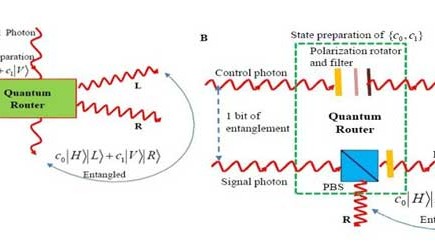Toward A Quantum Internet: World’s First Quantum Router
August 08, 2012
on
on

Quantum computers are the promise of the future. Harnessing the strange phenomena of quantum mechanics like ‘entanglement’ and ‘superposition’ could result in computers millions of times faster than our contemporary supercomputers and far more secure encryption.
When these computers are connected in a network of networks we’ll have a superfast, highly secure internet: the quantum internet.
Once we have the quantum internet established, April 12, 2012 can be marked as its date of birth when two coupled single-atom nodes communicated with each other at the Max Planck Institute for Quantum Optics in Germany.
But two computers do not a global network make. And until now physicists have been unable to send quantum data signals over more than one optical fibre because they were unable to route the signal. As soon as there are more than two nodes in a network a router needs to tell the signal which path to take but so far the control device could not interact with the signal without destroying it.
But now Chinese physicists have reported proof-of-principle of a working quantum router.
In classical packet switching networks like the internet a router retrieves the address information from the packet header to determine its destination. But on the quantum level reading the header would destroy the signal including its payload.
Classical bits exist in one of two states representing a 1 or a 0. Quantum bits or qubits can exist in a superposition of both states at the same time. Because of this a quantum computer using qubits can perform many computations where a binary computer can only perform one. The difficulty with superposition is the instant it is measured it collapses in a single state.
To work around the destruction of the signal before it has delivered its payload, Xiuying Chang of the Tsinghua University in Beijing and his colleagues used another aspect of quantum mechanics known as entanglement: two separate quantum objects sharing the same state. Therefore measuring the state of one of the entangled objects provides insight into the state of the other.
Chang and his team sent two entangled photons through their network. The router read out one of the photons to determine the destination (which was consequently destroyed) but the other could be sent on its way still carrying the data.
The Chinese quantum router will not be the device that will route our future quantum data. It has the critical limitation that it can’t handle more than one qubit at a time.
But it is proof routing is possible on a quantum level. And by doing so it has contributed a small piece to what once will be the quantum internet.
The paper Experimental Demonstration Of An Entanglement-based Quantum Router is published on arXiv.org
Source: TechnologyReview.com
When these computers are connected in a network of networks we’ll have a superfast, highly secure internet: the quantum internet.
Once we have the quantum internet established, April 12, 2012 can be marked as its date of birth when two coupled single-atom nodes communicated with each other at the Max Planck Institute for Quantum Optics in Germany.
But two computers do not a global network make. And until now physicists have been unable to send quantum data signals over more than one optical fibre because they were unable to route the signal. As soon as there are more than two nodes in a network a router needs to tell the signal which path to take but so far the control device could not interact with the signal without destroying it.
But now Chinese physicists have reported proof-of-principle of a working quantum router.
In classical packet switching networks like the internet a router retrieves the address information from the packet header to determine its destination. But on the quantum level reading the header would destroy the signal including its payload.
Classical bits exist in one of two states representing a 1 or a 0. Quantum bits or qubits can exist in a superposition of both states at the same time. Because of this a quantum computer using qubits can perform many computations where a binary computer can only perform one. The difficulty with superposition is the instant it is measured it collapses in a single state.
To work around the destruction of the signal before it has delivered its payload, Xiuying Chang of the Tsinghua University in Beijing and his colleagues used another aspect of quantum mechanics known as entanglement: two separate quantum objects sharing the same state. Therefore measuring the state of one of the entangled objects provides insight into the state of the other.
Chang and his team sent two entangled photons through their network. The router read out one of the photons to determine the destination (which was consequently destroyed) but the other could be sent on its way still carrying the data.
The Chinese quantum router will not be the device that will route our future quantum data. It has the critical limitation that it can’t handle more than one qubit at a time.
But it is proof routing is possible on a quantum level. And by doing so it has contributed a small piece to what once will be the quantum internet.
The paper Experimental Demonstration Of An Entanglement-based Quantum Router is published on arXiv.org
Source: TechnologyReview.com
Read full article
Hide full article



Discussion (0 comments)